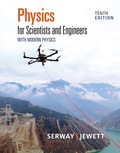
Physics for Scientists and Engineers with Modern Physics
10th Edition
ISBN: 9781337671729
Author: SERWAY
Publisher: Cengage
expand_more
expand_more
format_list_bulleted
Concept explainers
Question
Chapter 38, Problem 2P
To determine
To show: The momentum is conserved in a reference frame moving at
Expert Solution & Answer
Want to see the full answer?
Check out a sample textbook solution
Students have asked these similar questions
Part A
■Review
The uniform 150-lb stone (rectangular block) is being turned over on its side by pulling the
vertical cable slowly upward until the stone begins to tip.
(Figure 1)
If it then falls freely (T = 0) from an essentially balanced at-rest position, determine the speed at which the corner A strikes the pad at B. The stone does not slip at its corner C as it falls. Suppose that height of the stone is
L = 1.2 ft.
Express your answer to three significant figures and include the appropriate units.
?
ft
VA 10.76
S
Submit Previous Answers Request Answer
× Incorrect; Try Again; 6 attempts remaining
Consider the circuit shown in the figure. The battery has emf ε = 69 volts and negligible internal resistance. The inductance is L = 0.4 H and the resistances are R 1 = 12 Ω and R 2 = 9.0 Ω. Initially the switch S is open and no currents flow. Then the switch is closed. After leaving the switch closed for a very long time, it is opened again. Just after it is opened, what is the current in R 1?
A capacitor with a capacitance of C = 5.95×10−5 F is charged by connecting it to a 12.5 −V battery. The capacitor is then disconnected from the battery and connected across an inductor with an inductance of L = 1.55 H . At the time 2.35×10−2 s after the connection to the inductor is made, what is the current in the inductor? At that time, how much electrical energy is stored in the inductor?
Chapter 38 Solutions
Physics for Scientists and Engineers with Modern Physics
Ch. 38.1 - Which observer in Figure 38.1 sees the balls...Ch. 38.1 - Prob. 38.2QQCh. 38.4 - Suppose the observer O on the train in Figure 38.6...Ch. 38.4 - Prob. 38.4QQCh. 38.4 - Prob. 38.5QQCh. 38.4 - You are observing a spacecraft moving away from...Ch. 38.6 - You are driving on a freeway at a relativistic...Ch. 38.8 - Prob. 38.8QQCh. 38 - In a laboratory frame of reference, an observer...Ch. 38 - Prob. 2P
Ch. 38 - Prob. 3PCh. 38 - Prob. 4PCh. 38 - Prob. 5PCh. 38 - An astronaut is traveling in a space vehicle...Ch. 38 - Prob. 7PCh. 38 - You have been hired as an expert witness for an...Ch. 38 - Prob. 9PCh. 38 - Prob. 10PCh. 38 - Prob. 11PCh. 38 - A cube of steel has a volume of 1.00 cm3 and mass...Ch. 38 - Review. In 1963, astronaut Gordon Cooper orbited...Ch. 38 - You have an assistantship with a math professor in...Ch. 38 - Prob. 15PCh. 38 - Prob. 16PCh. 38 - A moving rod is observed to have a length of =...Ch. 38 - Prob. 18PCh. 38 - Prob. 19PCh. 38 - You have been hired as an expert witness in the...Ch. 38 - Figure P38.21 shows a jet of material (at the...Ch. 38 - Prob. 22PCh. 38 - Prob. 23PCh. 38 - Prob. 24PCh. 38 - Prob. 25PCh. 38 - Prob. 26PCh. 38 - Prob. 27PCh. 38 - (a) Find the kinetic energy of a 78.0-kg...Ch. 38 - Prob. 29PCh. 38 - Prob. 30PCh. 38 - Prob. 31PCh. 38 - Prob. 32PCh. 38 - Prob. 33PCh. 38 - Prob. 34PCh. 38 - Prob. 35PCh. 38 - Prob. 36PCh. 38 - Prob. 37PCh. 38 - Prob. 38PCh. 38 - Prob. 39PCh. 38 - An unstable particle with mass m = 3.34 1027 kg...Ch. 38 - Prob. 41PCh. 38 - Prob. 42APCh. 38 - Prob. 43APCh. 38 - Prob. 44APCh. 38 - Prob. 45APCh. 38 - Prob. 46APCh. 38 - Prob. 47APCh. 38 - Prob. 48APCh. 38 - Prob. 49APCh. 38 - Prob. 50APCh. 38 - Prob. 51APCh. 38 - Prob. 52APCh. 38 - The creation and study of new and very massive...Ch. 38 - Prob. 54CPCh. 38 - Prob. 55CP
Knowledge Booster
Learn more about
Need a deep-dive on the concept behind this application? Look no further. Learn more about this topic, physics and related others by exploring similar questions and additional content below.Similar questions
arrow_back_ios
SEE MORE QUESTIONS
arrow_forward_ios
Recommended textbooks for you
 University Physics Volume 3PhysicsISBN:9781938168185Author:William Moebs, Jeff SannyPublisher:OpenStax
University Physics Volume 3PhysicsISBN:9781938168185Author:William Moebs, Jeff SannyPublisher:OpenStax Classical Dynamics of Particles and SystemsPhysicsISBN:9780534408961Author:Stephen T. Thornton, Jerry B. MarionPublisher:Cengage Learning
Classical Dynamics of Particles and SystemsPhysicsISBN:9780534408961Author:Stephen T. Thornton, Jerry B. MarionPublisher:Cengage Learning Principles of Physics: A Calculus-Based TextPhysicsISBN:9781133104261Author:Raymond A. Serway, John W. JewettPublisher:Cengage Learning
Principles of Physics: A Calculus-Based TextPhysicsISBN:9781133104261Author:Raymond A. Serway, John W. JewettPublisher:Cengage Learning Modern PhysicsPhysicsISBN:9781111794378Author:Raymond A. Serway, Clement J. Moses, Curt A. MoyerPublisher:Cengage Learning
Modern PhysicsPhysicsISBN:9781111794378Author:Raymond A. Serway, Clement J. Moses, Curt A. MoyerPublisher:Cengage Learning Physics for Scientists and Engineers, Technology ...PhysicsISBN:9781305116399Author:Raymond A. Serway, John W. JewettPublisher:Cengage Learning
Physics for Scientists and Engineers, Technology ...PhysicsISBN:9781305116399Author:Raymond A. Serway, John W. JewettPublisher:Cengage Learning College PhysicsPhysicsISBN:9781938168000Author:Paul Peter Urone, Roger HinrichsPublisher:OpenStax College
College PhysicsPhysicsISBN:9781938168000Author:Paul Peter Urone, Roger HinrichsPublisher:OpenStax College

University Physics Volume 3
Physics
ISBN:9781938168185
Author:William Moebs, Jeff Sanny
Publisher:OpenStax

Classical Dynamics of Particles and Systems
Physics
ISBN:9780534408961
Author:Stephen T. Thornton, Jerry B. Marion
Publisher:Cengage Learning

Principles of Physics: A Calculus-Based Text
Physics
ISBN:9781133104261
Author:Raymond A. Serway, John W. Jewett
Publisher:Cengage Learning

Modern Physics
Physics
ISBN:9781111794378
Author:Raymond A. Serway, Clement J. Moses, Curt A. Moyer
Publisher:Cengage Learning

Physics for Scientists and Engineers, Technology ...
Physics
ISBN:9781305116399
Author:Raymond A. Serway, John W. Jewett
Publisher:Cengage Learning

College Physics
Physics
ISBN:9781938168000
Author:Paul Peter Urone, Roger Hinrichs
Publisher:OpenStax College